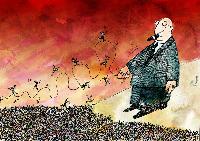
Poverty line is the level of income to meet the minimum living conditions.
Poverty line is the amount of money needed for a person to meet his basic needs. It is defined as the money value of the goods and services needed to provide basic welfare to an individual.
Poverty line differs from one country to another, depending upon the idea of poverty
Poverty line changes from one country to another. In developed countries, where there is advanced standard of living and welfare concepts, poverty line is high as basic standard to live include higher consumption requirements and accessibility to many goods and services.
On the other hand, in many less developed countries, the basic requirements will be low and contains mostly essential consumption items needed to sustain life. This means that poverty line is set by the welfare standard in a particular society (economy).
Poverty is ‘relative’ and what poverty in the US or in an advanced West European country may not be poverty in Bangladesh.
Poverty line in India
India is having a well-designed poverty measurement mechanism under the erstwhile Planning Commission. The Planning Commission was the nodal agency for estimation of poverty. For setting poverty line and methodology of constructing it, the Planning Commission appointed Expert Groups from time to time. For example, the Rangarajan Committee is the latest among those Expert groups. Traditionally, the planning commission estimates the number of people below poverty line in states as well as in the rural and urban areas based upon the prevailing poverty estimation methodology submitted by the expert groups.
Methodology for constructing the poverty line
The poverty estimation methodology was revised many times with new expert group/task force appointed by the Planning Commission to look into the matter. Each expert group/task force has devised certain methodology in determining the poverty line.
For measuring poverty, a poverty line is set. The poverty line is the level of income needed to meet the minimum standard of living. People who have an income less than this is considered as below poverty line.
The concept about minimum consumption standards and consumption levels were changed based upon recommendations of the various expert groups/task force. These expert groups uses the NSS (National Sample Survey) estimate about the consumption pattern of households from time to time. The NSS’s periodically makes extensive household surveys on expenditure. Here, from the preferred consumption basket of the people, the expert groups pick up the most essential commodities. These commodities are placed under a poverty line basket (PLB).
Minimum standard of living is thus expressed as the basket of goods and services commonly used by the people. Based on this consumption pattern, the Expert Groups estimate the minimum consumption levels (and the income needed to buy these) and the income needed to obtain these goods and services in both rural and urban areas. This income level acts as the poverty line.
Poverty line methodology is changing in India
Extending from the first attempt to set a poverty line – the Working Group of 1962 to the Rangarajan Task Force (2014), poverty estimation methodology has undergone an evolution in India.
Poverty is measured in terms of the Head Count Poverty Ratio (HCPR) as in several other countries. The HCPR is the percentage of the population under the poverty line. This means that it is the absolute poverty that is estimated in India. Poverty ratio is measured in terms of per capita consumption expenditure over a month.
*********








